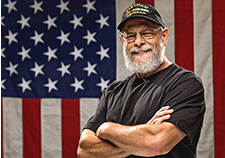Office of Research & Development |
 |
Office of Research & Development |
 |


A new study focused on patients in Massachusetts found greater opioid risks for those receiving prescriptions in both VA and non-VA pharmacies, versus those using VA alone. (Photo: ©iStock/Mladen Zivkovic)
December 4, 2018
By Tristan Horrom
VA Research Communications
The researchers suggest several steps to reduce dangerous co-prescribing of opioids to patients using more than one health care system.
Veterans in Massachusetts who had opioid prescriptions filled by both VA and non-VA pharmacies had worse outcomes than who receiving prescriptions from VA only, according to a new study. Researchers at the Edith Nourse Rogers Memorial Veterans Hospital, in Bedford, Massachusetts, used an innovative linked database developed by the Massachusetts Department of Public Health to study the opioid overdose epidemic. They found that dual use patients were at higher risk for opioid overdoses and death from any cause.
The results appeared in the November 2018 American Journal of Managed Care.
Many Veterans receive medical care from both VA and other providers, often covered by Medicare. Additionally, the Veterans Choice Program and other programs have led to more Veterans receiving care outside the Veterans Health Administration. The programs allow Veterans in certain circumstances to receive care from a community health care provider, paid for by VA. Patients are eligible if receiving care at a VA facility is difficult—for example, if they live in a rural area not close to a VA medical center.

VA ear surgeon studies management of severe hearing loss in Veterans

Veteran disability payments led to fewer hospitalizations

Air Force Veteran among 10 new awardees in VA diversity, equity, and inclusion research program

VA researcher leads project to evaluate Veteran screening for malnutrition
The increase in dual use patients has led to challenges in coordinating care between different systems. To get a better picture of these challenges, the researchers looked at how dual use practices affected 16,866 Veterans in Massachusetts who were prescribed opioids over a two-year period.
Of those patients, 55 percent received opioid prescriptions through VA pharmacies only, while the remaining 45 percent filled prescriptions at both VA and non-VA pharmacies. The differences between opioid prescription patterns were significant.
Twenty-six percent of dual care patients in the study received high-dose opioid therapy. In contrast, only 7 percent of VA-only patients received high-dose opioids. While only 8 percent of VA-only patients had prescriptions for both opioids and benzodiazepines, 35 percent of dual care patients were prescribed both drugs. Benzodiazepines are drugs commonly prescribed to treat anxiety, insomnia, and alcohol withdrawal. Taken together, opioids and benzodiazepines have a tenfold higher risk of overdose than opioids alone. Furthermore, 7 percent of dual use patients received a diagnosis of opioid use disorder, compared with 2 percent of VA-only patients.
The researchers also found that dual-use patients had worse health outcomes. These patients had higher odds of having a non-fatal opioid overdose than VA-only patients. The study did not show higher odds of fatal opioid overdoses. Despite this finding, the dual use group had higher mortality from any cause than the VA-only group. More than 9 percent of dual-use patients died during the study period, compared with only 4 percent of VA-only patients.
The results highlight the importance of using prescription monitoring programs to reduce fractured care between multiple health care providers, according to the researchers. Dual care use “is leading to greater likelihood of uncoordinated care among Veterans across the United States,” they write.
VA’s Opioid Safety Initiative requires VA doctors to share data on controlled substance prescribing with state prescription monitoring programs. VA also uses pain management teams to coordinate and oversee pain management therapy. These teams check state prescription monitoring programs at least annually to look for co-prescribing of opioids. The findings show the need to continue to share data between VA and other systems in this way, say the researchers.
The researchers caution that the results cannot be applied to the country’s general population. While the data from Massachusetts suggest a need for more coordination between different health care systems, the researchers point out that different communities have different cultures and structures that could influence how these relationships work.
Nevertheless, the researchers suggest several further steps to cut down on dangerous co-prescribing of opioids to patients using more than one health care system. More education on safe opioid prescribing procedures are needed, both within and outside VA, they say. They suggest the aggressive dispensing of naloxone—a medication that blocks the effects of opioids, which can reverse the effects of an overdose if given correctly—to Veterans taking opioids, and to their families. The researchers recommend that dual care users be provided more resources and closer care coordination, such as pharmacy education and case management, to make sure their opioid use is safe. Finally, they recommend implementing prescription drug disposal to help patients get rid of unused medications.
To learn more about VA’s efforts to combat dangerous opioid use, visit the Substance Use Disorders topic page.
VA Research Currents archives || Sign up for VA Research updates